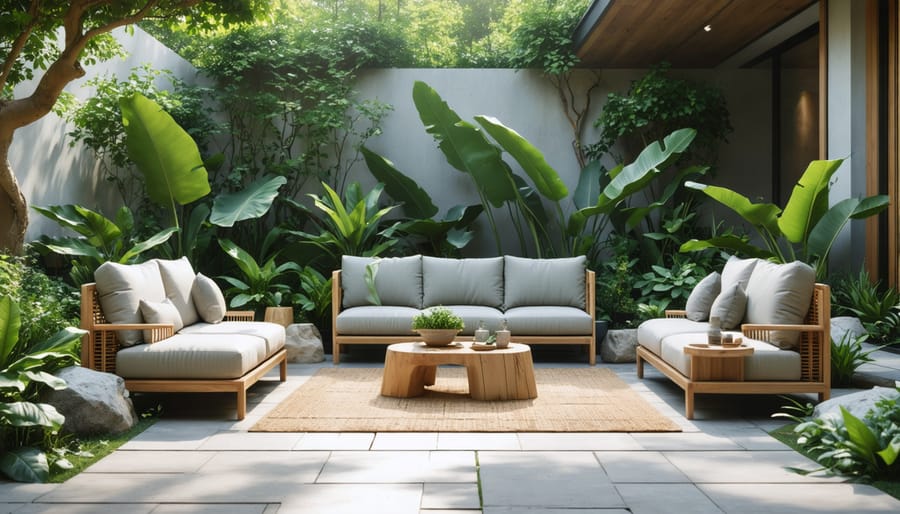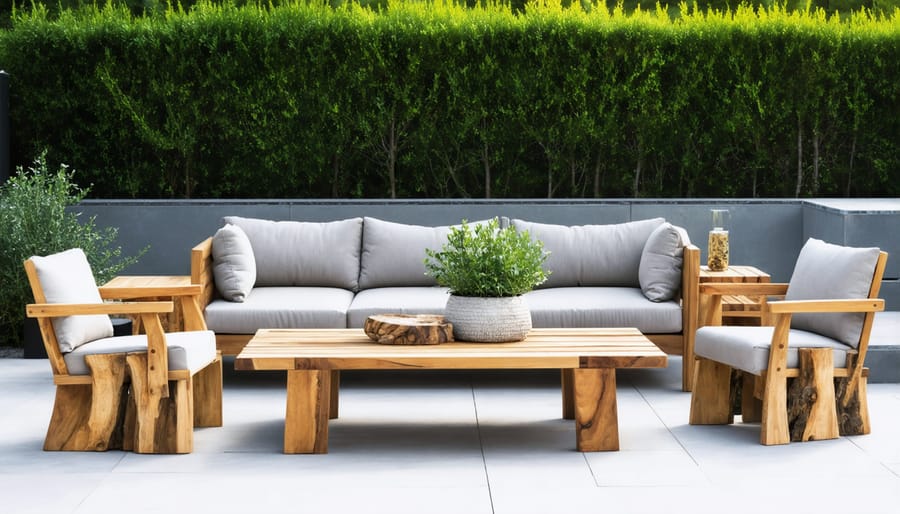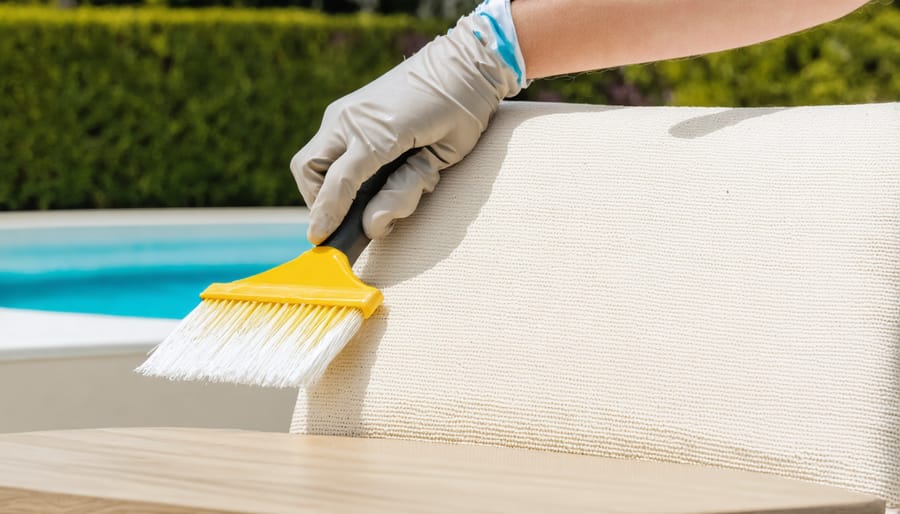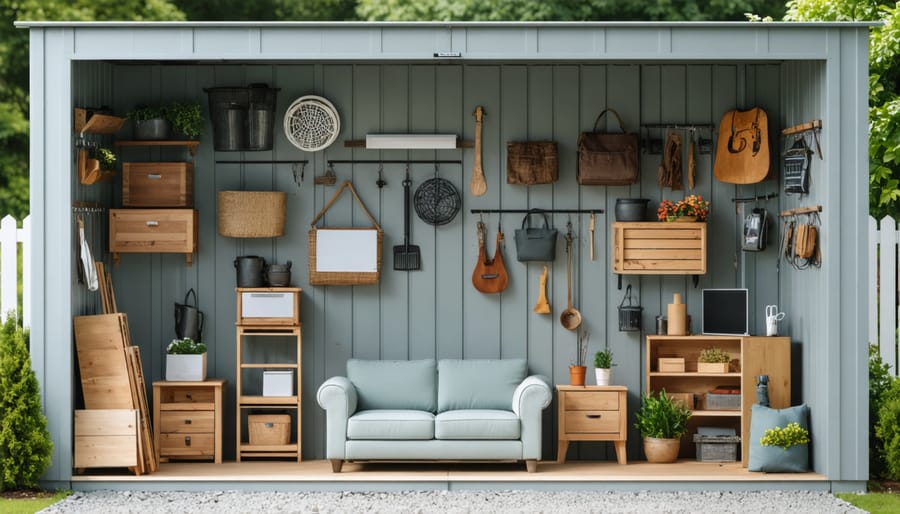Beautiful Outdoor Furniture That’s Built to Last (And Won’t Harm the Planet)

Transform your outdoor living space into an eco-conscious sanctuary by choosing sustainable furniture that combines style, durability, and environmental responsibility. Modern sustainable outdoor furniture goes beyond basic recycled materials, embracing innovative solutions like reclaimed teak, Forest Stewardship Council (FSC) certified wood, and advanced recycled polymers that withstand harsh weather while minimizing environmental impact. When crafting an eco-friendly patio design, selecting the right sustainable furniture becomes a cornerstone of responsible outdoor living.
Today’s sustainable outdoor pieces offer remarkable longevity, often outlasting traditional alternatives while requiring minimal maintenance and reducing long-term replacement needs. By investing in weather-resistant materials like bamboo, recycled aluminum, or responsibly sourced hardwoods, homeowners can create stunning outdoor spaces that reflect their environmental values without compromising on aesthetics or functionality. These materials not only reduce deforestation and waste but also support local artisans and sustainable manufacturing practices, making every purchase a step toward a greener future.
Eco-Friendly Materials Revolutionizing Outdoor Furniture
Reclaimed and FSC-Certified Woods
When it comes to creating sustainable outdoor living spaces, choosing the right wood is crucial. Reclaimed wood and FSC-certified materials are two excellent options that combine environmental responsibility with stunning aesthetics. Reclaimed wood gives outdoor furniture a unique character while preventing further deforestation. Each piece tells a story, whether it’s sourced from old barns, retired sailing vessels, or dismantled buildings.
FSC (Forest Stewardship Council) certification ensures that wood comes from responsibly managed forests. This certification guarantees that trees are harvested sustainably, protecting wildlife habitats and supporting local communities. Common FSC-certified woods for outdoor furniture include teak, acacia, and eucalyptus, all known for their natural resistance to weather and insects.
Look for furniture makers who provide documentation of their wood sources. Many reputable manufacturers proudly display FSC certification labels and can trace their reclaimed materials’ origins. These sustainable choices not only create beautiful outdoor spaces but also help preserve our forests for future generations.

Recycled Plastics and Polymers
Recycled plastics and polymers have revolutionized sustainable outdoor furniture, offering an eco-friendly alternative that combines durability with environmental responsibility. These materials give new life to post-consumer plastics that would otherwise end up in landfills, transforming them into stylish and weather-resistant furniture pieces.
Modern recycled plastic furniture comes in various styles and colors, often mimicking the look of traditional materials like wood or wicker. Made from materials such as recycled milk jugs, plastic bottles, and industrial waste, these pieces are incredibly resilient against rain, sun, and temperature fluctuations. They won’t crack, splinter, or require regular maintenance beyond occasional cleaning.
What makes recycled plastic furniture particularly appealing is its longevity. Unlike traditional materials that may need replacement every few years, these pieces can last decades while maintaining their appearance. They’re also completely recyclable at the end of their life cycle, creating a closed-loop system that benefits the environment.
For homeowners concerned about comfort, many manufacturers now incorporate ergonomic designs and textures that ensure these eco-friendly options are as comfortable as they are sustainable.
Bamboo and Fast-Growing Alternatives
Bamboo stands out as a star player in sustainable outdoor furniture, growing up to 3 feet per day and reaching maturity in just 3-5 years. This remarkable renewable resource offers excellent durability while maintaining a sleek, modern appearance. Other fast-growing alternatives include eucalyptus, which matures in 4-6 years and provides natural weather resistance, and acacia, known for its robust nature and beautiful grain patterns. These materials not only reduce environmental impact but also bring unique character to your outdoor space. When treated properly, bamboo and these alternatives can withstand various weather conditions, making them practical choices for long-term outdoor use. Plus, their rapid growth rates mean forests can be replenished quickly, ensuring a sustainable supply for future generations.
Weather-Resistant Features That Extend Furniture Life
UV-Resistant Finishes
UV-resistant finishes play a crucial role in extending the life of your sustainable outdoor furniture while maintaining its aesthetic appeal. These protective treatments act as a shield against harmful ultraviolet rays, which can cause fading, discoloration, and material degradation over time. When choosing sustainable furniture, look for pieces treated with eco-friendly UV protectants derived from natural sources like plant-based oils and waxes.
Water-based UV-resistant finishes are particularly environmentally friendly, offering excellent protection without harmful VOCs (volatile organic compounds). These treatments work harmoniously with your outdoor lighting solutions and other exterior elements while maintaining the furniture’s natural appearance.
For maximum effectiveness, consider furniture with multi-layer UV protection systems. The initial sealant penetrates the material, while subsequent layers create a durable barrier against sun damage. Many sustainable manufacturers now incorporate nano-technology in their UV treatments, providing superior protection while using fewer resources.
Regular maintenance of UV-resistant finishes is straightforward – simply clean the furniture surfaces periodically and reapply protective treatments annually. This proactive approach ensures your sustainable outdoor furniture remains beautiful and functional for years to come, reducing the need for replacement and supporting environmental conservation.

Moisture-Fighting Technologies
Modern sustainable outdoor furniture incorporates innovative moisture-fighting technologies that extend its lifespan while maintaining eco-friendly credentials. Water-resistant treatments derived from natural sources, such as plant-based waxes and oils, create effective barriers against moisture without harmful chemicals. These treatments penetrate deep into natural materials like bamboo and reclaimed wood, offering lasting protection while preserving their natural beauty.
Many sustainable furniture pieces now feature specially designed drainage systems and elevated bases that prevent water accumulation. Quick-dry materials like recycled marine-grade polymers and moisture-wicking fabrics ensure your furniture dries rapidly after rain, reducing the risk of mold and mildew growth.
Manufacturers are also incorporating innovative joint designs that allow water to flow freely instead of collecting in corners and crevices. Some pieces feature removable cushions with water-resistant covers made from recycled materials, making them both practical and environmentally conscious.
For wooden furniture, new eco-friendly sealants use nano-technology to create microscopic barriers that repel water while allowing the wood to breathe naturally. These advanced solutions ensure your sustainable outdoor furniture remains beautiful and functional throughout the seasons while staying true to environmental principles.
Maintenance Tips for Long-Lasting Sustainable Furniture
Seasonal Care Guidelines
To maintain your sustainable outdoor furniture throughout the year, follow these season-specific guidelines to ensure longevity and optimal performance. During spring, thoroughly clean your furniture using eco-friendly cleaners and inspect for any winter damage. Apply natural protective oils to wooden pieces and tighten any loose hardware before the outdoor season begins.
Summer care focuses on protection from intense UV rays and heat. Position furniture in partially shaded areas when possible, and use environmentally friendly fabric protectors on cushions. Regularly dust and wipe down surfaces to prevent dirt buildup, and store cushions in a dry place during unexpected summer storms.
As autumn approaches, prepare your furniture for changing weather conditions. Clean fallen leaves promptly to prevent staining and moisture damage. Consider using breathable furniture covers made from sustainable materials during extended periods of non-use.
Winter requires the most attention to protect your investment. Store lighter pieces in a covered area or climate-controlled space. For heavier items that must remain outdoors, use weather-resistant covers and elevate them slightly off the ground to prevent moisture absorption. If using wooden furniture, apply an additional coat of natural sealant before the cold season sets in.
Remember to check your furniture monthly regardless of season, addressing any maintenance needs promptly to prevent minor issues from becoming major problems.
Eco-Friendly Cleaning Solutions
Keeping your sustainable outdoor furniture clean doesn’t have to harm the environment. Create an effective cleaning solution by mixing equal parts white vinegar and water in a spray bottle. This natural combination effectively removes dirt, mildew, and light stains while being gentle on both your furniture and the planet.
For wooden furniture, a mixture of mild castile soap and warm water works wonders. Simply wipe down surfaces with a soft cloth, and avoid harsh scrubbing that might damage the wood’s natural finish. Baking soda makes an excellent natural abrasive for tackling tough stains – create a paste with water and gently work it into problem areas.
For metal or plastic pieces, a solution of two tablespoons of citrus-based dish soap in a gallon of warm water provides excellent cleaning power without harsh chemicals. Regular maintenance with these eco-friendly solutions helps extend your furniture’s life while protecting the environment.
Don’t forget to dry your furniture thoroughly after cleaning to prevent water damage. For an extra protective boost, consider applying natural oils like linseed or tung oil to wooden pieces, which create a protective barrier without harmful chemicals.
Remember to test any cleaning solution on a small, hidden area first to ensure it won’t affect the furniture’s finish or color. Store your homemade cleaning solutions in clearly labeled containers and keep them in a cool, dry place for future use.
Smart Storage Solutions for Sustainable Furniture
Proper Storage Techniques
Proper storage is crucial for extending the life of your sustainable outdoor furniture and maintaining its beauty year after year. During off-seasons or severe weather, protect your investment by storing pieces in a dry, climate-controlled environment whenever possible.
For wooden furniture, ensure all pieces are thoroughly cleaned and completely dry before storage to prevent mold growth. Apply a protective sealant or oil to wooden surfaces before storing to maintain moisture resistance. Consider using furniture covers made from breathable materials to prevent condensation while protecting from dust and debris.
Metal furniture should be inspected for any signs of rust and treated accordingly before storage. Remove cushions and store them separately in weatherproof containers to prevent mildew. For wicker or rattan pieces, elevate them off the ground using pallets or blocks to ensure proper air circulation and prevent moisture damage.
When space is limited, look for stackable furniture options or pieces that can be disassembled. Many sustainable furniture designs now feature modular components that can be easily taken apart for compact storage. Keep all hardware organized in labeled containers to prevent loss during the storage period.
For quick access during unexpected weather changes, keep furniture covers readily available. Create a simple maintenance checklist to ensure all necessary steps are taken before and after storage periods. This systematic approach will help preserve your sustainable outdoor furniture’s integrity and extend its lifespan, making your eco-friendly investment truly worthwhile.
Storage Shed Organization
Proper storage organization is crucial for extending the life of your sustainable outdoor furniture and maintaining its eco-friendly benefits. Start by thoroughly cleaning each piece before storage, using gentle, environmentally friendly cleaners to remove dirt and debris. This prevents moisture-related issues and preserves the natural materials.
Create designated zones within your storage shed based on furniture size and frequency of use. Position larger items like tables and loungers against the back wall, with smaller pieces and accessories toward the front for easy access. Consider installing wall-mounted hooks or pegboards for hanging cushions, helping them maintain their shape while preventing mold growth.
Protect wooden furniture by elevating it slightly off the ground using pallets or blocks, which promotes air circulation and prevents moisture absorption. For items made from recycled plastics or sustainable metals, use breathable furniture covers made from natural materials rather than plastic sheets, which can trap moisture and encourage mildew.
Maximize vertical space by installing adjustable shelving units for smaller items and storage boxes containing furniture accessories. Label everything clearly to make seasonal transitions smoother. If possible, incorporate a small dehumidifier or moisture-absorbing products to maintain optimal storage conditions.
Remember to leave enough walking space between furniture pieces for easy access and regular checks. This organization system not only protects your investment in sustainable furniture but also makes it simpler to rotate pieces seasonally while maintaining their eco-friendly qualities.

Choosing sustainable outdoor furniture represents more than just a trend – it’s a meaningful step toward creating environmentally conscious outdoor spaces that benefit both our planet and our daily lives. By investing in eco-friendly furniture options, we’re not only reducing our environmental footprint but also ensuring long-lasting quality that withstands the test of time.
The benefits of sustainable outdoor furniture are clear: reduced deforestation, lower carbon emissions, and decreased waste in landfills. These pieces often bring unique character to our outdoor spaces while supporting responsible manufacturing practices and local artisans. Moreover, sustainable furniture typically offers superior durability, requiring less frequent replacement and ultimately providing better value for your investment.
As we’ve explored throughout this guide, sustainable materials like reclaimed wood, recycled plastics, and bamboo can create stunning outdoor spaces without compromising on style or comfort. By choosing these environmentally responsible options, we’re making a positive impact that extends far beyond our own backyards.
Remember, every sustainable furniture choice contributes to a healthier planet for future generations. Whether you’re furnishing a small balcony or a sprawling patio, consider making your next outdoor furniture purchase one that aligns with eco-friendly principles. Your outdoor space will not only look beautiful but also reflect your commitment to environmental stewardship.

